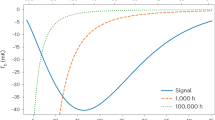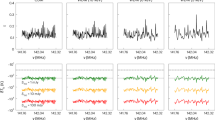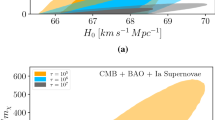Abstract
The cosmic radio-frequency spectrum is expected to show a strong absorption signal corresponding to the 21-centimetre-wavelength transition of atomic hydrogen around redshift 20, which arises from Lyman-α radiation from some of the earliest stars1,2,3,4. By observing this 21-centimetre signal—either its sky-averaged spectrum5 or maps of its fluctuations, obtained using radio interferometers6,7—we can obtain information about cosmic dawn, the era when the first astrophysical sources of light were formed. The recent detection of the global 21-centimetre spectrum5 reveals a stronger absorption than the maximum predicted by existing models, at a confidence level of 3.8 standard deviations. Here we report that this absorption can be explained by the combination of radiation from the first stars and excess cooling of the cosmic gas induced by its interaction with dark matter8,9,10. Our analysis indicates that the spatial fluctuations of the 21-centimetre signal at cosmic dawn could be an order of magnitude larger than previously expected and that the dark-matter particle is no heavier than several proton masses, well below the commonly predicted mass of weakly interacting massive particles. Our analysis also confirms that dark matter is highly non-relativistic and at least moderately cold, and primordial velocities predicted by models of warm dark matter are potentially detectable. These results indicate that 21-centimetre cosmology can be used as a dark-matter probe.
This is a preview of subscription content, access via your institution
Access options
Access Nature and 54 other Nature Portfolio journals
Get Nature+, our best-value online-access subscription
$29.99 / 30 days
cancel any time
Subscribe to this journal
Receive 51 print issues and online access
$199.00 per year
only $3.90 per issue
Buy this article
- Purchase on Springer Link
- Instant access to full article PDF
Prices may be subject to local taxes which are calculated during checkout



Similar content being viewed by others
References
Madau, P., Meiksin, A. & Rees, M. J. 21 centimeter tomography of the intergalactic medium at high redshift. Astrophys. J. 475, 429–444 (1997)
Tozzi, P., Madau, P., Meiksin, A. & Rees, M. J. Radio signatures of H i at high redshift: mapping the end of the “dark ages”. Astrophys. J. 528, 597–606 (2000)
Furlanetto, S. R., Oh, S. P. & Briggs, F. H. Cosmology at low frequencies: the 21 cm transition and the high-redshift Universe. Phys. Rep. 433, 181–301 (2006)
Barkana, R. The rise of the first stars: supersonic streaming, radiative feedback, and 21-cm cosmology. Phys. Rep. 645, 1–59 (2016)
Bowman, J. D., Rogers, A. E. E., Monsalve, R. A., Mozdzen, T. J. & Mahesh, N. An absorption profile centred at 78 megahertz in the sky-averaged spectrum. Nature 555, https://doi.org/10.1038/nature25792 (2018)
DeBoer, D. R. et al. Hydrogen Epoch of Reionization Array (HERA). Publ. Astron. Soc. Pacif. 129, 045001 (2017)
Koopmans, L. et al. The cosmic dawn and epoch of reionisation with SKA. In Proc. Advancing Astrophysics with the Square Kilometre Array (Proceedings of Science, 2015)
Dvorkin, C., Blum, K. & Kamionkowski, M. Constraining dark matter–baryon scattering with linear cosmology. Phys. Rev. D 89, 023519 (2014)
Tashiro, H., Kadota, K. & Silk, J. Effects of dark matter-baryon scattering on redshifted 21 cm signals. Phys. Rev. D 90, 083522 (2014)
Muñoz, J. B., Kovetz, E. D. & Ali-Haïmoud, Y. Heating of baryons due to scattering with dark matter during the dark ages. Phys. Rev. D 92, 083528 (2015)
Purcell, E. M. & Field, G. B. Influence of collisions upon population of hyperfine states in hydrogen. Astrophys. J. 124, 542–549 (1956)
Hogan, C. J. & Rees, M. J. Spectral appearance of non-uniform gas at high z. Mon. Not. R. Astron. Soc. 188, 791–798 (1979)
Scott, D. & Rees, M. J. The 21-cm line at high redshift: a diagnostic for the origin of large scale structure. Mon. Not. R. Astron. Soc. 247, 510–516 (1990)
Furlanetto, S. R. The global 21-centimeter background from high redshifts. Mon. Not. R. Astron. Soc. 371, 867–878 (2006)
Fialkov, A., Barkana, R. & Visbal, E. The observable signature of late heating of the Universe during cosmic reionization. Nature 506, 197–199 (2014)
Wouthuysen, S. A. On the excitation mechanism of the 21-cm (radio-frequency) interstellar hydrogen emission line. Astron. J. 57, 31–32 (1952)
Field, G. B. Excitation of the hydrogen 21-cm line. Proc. IRE 46, 240–250 (1958)
Chuzhoy, L., & Kolb, E. W. Reopening the window on charged dark matter. J. Cosmol. Astropart. Phys. 7, 14 (2009)
McDermott, S. D., Yu, H.-B. & Zurek, K. M. Turning off the lights: how dark is dark matter? Phys. Rev. D 83, 063509 (2011)
Sunyaev, R. A. & Zeldovich, Y. B. Small-scale fluctuations of relic radiation. Astrophys. Space Sci. 7, 3–19 (1970)
Tseliakhovich, D. & Hirata, C. Relative velocity of dark matter and baryonic fluids and the formation of the first structures. Phys. Rev. D 82, 083520 (2010)
Dalal, N., Pen, U.-L. & Seljak, U. Large-scale BAO signatures of the smallest galaxies. J. Cosmol. Astropart. Phys. 11, 7 (2010)
Visbal, E., Barkana, R., Fialkov, A., Tseliakhovich, D. & Hirata, C. M. The signature of the first stars in atomic hydrogen at redshift 20. Nature 487, 70–73 (2012)
XENON Collaboration. First dark matter search results from the XENON1T experiment. Phys. Rev. Lett. 119, 181301 (2017)
PandaX-II Collaboration. Dark matter results from 54-ton-day exposure of PandaX-II experiment. Phys. Rev. Lett. 119, 181302 (2017)
Hu, W., Barkana, R. & Gruzinov, A. Fuzzy cold dark matter: the wave properties of ultralight particles. Phys. Rev. Lett. 85, 1158–1161 (2000)
Iršicˇ, V. et al. New constraints on the free-streaming of warm dark matter from intermediate and small scale Lyman-α forest data. Phys. Rev. D 96, 023522 (2017)
Singh, S. et al. First results on the epoch of reionization from first light with SARAS 2. Astrophys. J. 845, L12 (2017)
Bernardi, G., McQuinn, M. & Greenhill, L. J. Foreground model and antenna calibration errors in the measurement of the sky-averaged λ21 cm signal at z ~ 20. Astrophys. J. 799, 90 (2015)
Alam, S. et al. The clustering of galaxies in the completed SDSS-III Baryon Oscillation Spectroscopic Survey: cosmological analysis of the DR12 galaxy sample. Mon. Not. R. Astron. Soc. 470, 2617–2652 (2017)
Cohen, A., Fialkov, A., Barkana, R. & Lotem, M. Charting the parameter space of the global 21-cm signal. Mon. Not. R. Astron. Soc. 472, 1915–1931 (2017)
Barkana, R. & Loeb, A. Detecting the earliest galaxies through two new sources of 21 centimeter fluctuations. Astrophys. J. 626, 1–11 (2005)
Pritchard, J. R. & Furlanetto, S. 21-cm fluctuations from inhomogeneous X-ray heating before reionization. Mon. Not. R. Astron. Soc. 376, 1680–1694 (2007)
Planck Collaboration. Planck 2015 results. XIII. Cosmological parameters. Astron. Astrophys. 594, A13 (2016)
Ali-Haïmoud, Y. & Hirata, C. M. HyRec: a fast and highly accurate primordial hydrogen and helium recombination code. Phys. Rev. D 83, 043513 (2011)
McQuinn, M. The evolution of the intergalactic medium. Annu. Rev. Astron. Astrophys. 54, 313–362 (2016)
Miralda-Escudé, J., Haehnelt, M. & Rees, M. J. Reionization of the inhomogeneous Universe. Astrophys. J. 530, 1–16 (2000)
Ross, H. E., Dixon, K. L., Iliev, I. T. & Mellema, G. Simulating the impact of X-ray heating during the cosmic dawn. Mon. Not. R. Astron. Soc. 468, 3785–3797 (2017)
O’Leary, R. M. & McQuinn, M. The formation of the first cosmic structures and the physics of the z ~ 20 Universe. Astrophys. J. 760, 4 (2012)
Semelin, B., Eames, E., Bolgar, F. & Caillat, M. 21SSD: a public data base of simulated 21-cm signals from the epoch of reionization. Mon. Not. R. Astron. Soc. 472, 4508–4520 (2017)
Gnedin, N. Y. & Hui, L. Probing the Universe with the Lyα forest – I. Hydrodynamics of the low-density intergalactic medium. Mon. Not. R. Astron. Soc. 296, 44–55 (1998)
Naoz, S. & Barkana, R. The formation and gas content of high-redshift galaxies and minihaloes. Mon. Not. R. Astron. Soc. 377, 667–676 (2007)
Monsalve, R. A., Rogers, A. E. E., Bowman, J. D. & Mozdzen, T. J. Results from EDGES High-band. I. Constraints on phenomenological models for the global 21 cm signal. Astrophys. J. 847, 64 (2017)
Ali, Z. S. et al. PAPER-64 constraints on reionization: the 21 cm power spectrum at z = 8.4. Astrophys. J. 809, 61 (2015)
Patil, A. H. et al. Upper limits on the 21 cm epoch of reionization power spectrum from one night with LOFAR. Astrophys. J. 838, 65 (2017)
Beardsley, A. P. et al. First season MWA EoR power spectrum results at redshift 7. Astrophys. J. 833, 102 (2016)
Paciga, G. et al. A simulation-calibrated limit on the H i power spectrum from the GMRT Epoch of Reionization experiment. Mon. Not. R. Astron. Soc. 433, 639–647 (2013)
Chuzhoy, L. & Shapiro, P. R. Ultraviolet pumping of hyperfine transitions in the light elements, with application to 21 cm hydrogen and 92 cm deuterium lines from the early universe. Astrophys. J. 651, 1–7 (2006)
Chen, X. & Miralda-Escudé, J. The spin-kinetic temperature coupling and the heating rate due to Lyα scattering before reionization: predictions for 21 centimeter emission and absorption. Astrophys. J. 602, 1–11 (2004)
Hirata, C. M. Wouthuysen–Field coupling strength and application to high-redshift 21-cm radiation. Mon. Not. R. Astron. Soc. 367, 259–274 (2006)
Furlanetto, S. R. & Pritchard, J. R. The scattering of Lyman-series photons in the intergalactic medium. Mon. Not. R. Astron. Soc. 372, 1093–1103 (2006)
Chuzhoy, L. & Shapiro, P. R. Heating and cooling of the early intergalactic medium by resonance photons. Astrophys. J. 655, 843–846 (2007)
Hui, L., Ostriker, J. P., Tremaine, S. & Witten, E. Ultralight scalars as cosmological dark matter. Phys. Rev. D 95, 043541 (2017)
Burns, J. O. et al. Probing the first stars and black holes in the early Universe with the Dark Ages Radio Explorer (DARE). Adv. Space Res. 49, 433–450 (2012)
Ali-Haïmoud, Y., Chluba, J. & Kamionkowski, M. Constraints on dark matter interactions with standard model particles from cosmic microwave background spectral distortions. Phys. Rev. Lett. 115, 071304 (2015)
Essig, R., Volansky, T. & Yu, T.-T. New constraints and prospects for sub-GeV dark matter scattering off electrons in xenon. Phys. Rev. D 96, 043017 (2017)
Spergel, D. N. & Steinhardt, P. J. Observational evidence for self-interacting cold dark matter. Phys. Rev. Lett. 84, 3760–3763 (2000)
Davidson, S., Hannestad, S. & Raffelt, G. Updated bounds on milli-charged particles. J. High Energy Phys. 5, 3 (2000)
Dubovsky, S. L., Gorbunov, D. S. & Rubtsov, G. I. Narrowing the window for millicharged particles by CMB anisotropy. J. Exp. Theor. Phys. 79, 1–5 (2004)
Read, J. I. The local dark matter density. J. Phys. G 41, 063101 (2014)
Kadota, K ., Sekiguchi, T. & Tashiro, H. A new constraint on millicharged dark matter from galaxy clusters. Preprint at https://arxiv.org/abs/1602.04009 (2016)
Zaharijas, G. & Farrar, G. R. Window in the dark matter exclusion limits. Phys. Rev. D 72, 083502 (2005)
Rich, J., Rocchia, R. & Spiro, M. A search for strongly interacting dark matter. Phys. Lett. B 194, 173–176 (1987)
Erickcek, A. L., Steinhardt, P. J., McCammon, D. & McGuire, P. C. Constraints on the interactions between dark matter and baryons from the x-ray quantum calorimetry experiment. Phys. Rev. D 76, 042007 (2007)
Budnik, R ., Chesnovsky, O ., Slone, O. & Volansky, T. Direct detection of light dark matter and solar neutrinos via color center production in crystals. Preprint at https://arxiv.org/abs/1705.03016 (2017)
Battaglieri, M . et al. US cosmic visions: new ideas in dark matter 2017: community report. Preprint at https://arxiv.org/abs/1707.04591 (2017)
Starkman, G. D., Gould, A., Esmailzadeh, R. & Dimopoulos, S. Opening the window on strongly interacting dark matter. Phys. Rev. D 41, 3594–3603 (1990)
Mack, G. D., Beacom, J. F. & Bertone, G. Towards closing the window on strongly interacting dark matter: far-reaching constraints from Earth’s heat flow. Phys. Rev. D 76, 043523 (2007)
Alekhin, S. et al. A facility to search for hidden particles at the CERN SPS: the SHiP physics case. Rep. Prog. Phys. 79, 124201 (2016)
Cyburt, R. H., Fields, B. D., Pavlidou, V. & Wandelt, B. Constraining strong baryon-dark-matter interactions with primordial nucleosynthesis and cosmic rays. Phys. Rev. D 65, 123503 (2002)
Muñoz, J. B. & Loeb, A. Constraints on dark-matter-baryon scattering from the temperature evolution of the intergalactic medium. J. Cosmol. Astropart. Phys. 2017, 043 (2017)
Mesinger, A., Furlanetto, S. & Cen, R. 21CMFAST: a fast, seminumerical simulation of the high-redshift 21-cm signal. Mon. Not. R. Astron. Soc. 411, 955–972 (2011)
Acknowledgements
I am grateful to J. Bowman for alerting me to possible indications of very deep absorption in the EDGES results, which inspired this work. This project was made possible through the support of a grant from the John Templeton Foundation. The opinions expressed in this publication are those of the author and do not necessarily reflect the views of the John Templeton Foundation.
Author information
Authors and Affiliations
Corresponding author
Ethics declarations
Competing interests
The author declares no competing financial interests.
Additional information
Publisher's note: Springer Nature remains neutral with regard to jurisdictional claims in published maps and institutional affiliations.
Rights and permissions
About this article
Cite this article
Barkana, R. Possible interaction between baryons and dark-matter particles revealed by the first stars. Nature 555, 71–74 (2018). https://doi.org/10.1038/nature25791
Received:
Accepted:
Published:
Issue Date:
DOI: https://doi.org/10.1038/nature25791
This article is cited by
-
Signals from the depths of the cosmos
Nature India (2024)
-
Prospects for precision cosmology with the 21 cm signal from the dark ages
Nature Astronomy (2023)
-
PRATUSH experiment concept and design overview
Experimental Astronomy (2023)
-
Studying cosmic dawn using redshifted HI 21-cm signal: A brief review
Journal of Astrophysics and Astronomy (2023)
-
Synthetic observations with the Square Kilometre Array: Development towards an end-to-end pipeline
Journal of Astrophysics and Astronomy (2023)
Comments
By submitting a comment you agree to abide by our Terms and Community Guidelines. If you find something abusive or that does not comply with our terms or guidelines please flag it as inappropriate.



